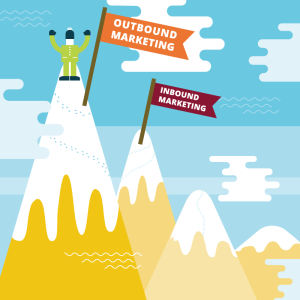Inbound Marketing vs Outbound Marketing
Inbound Marketing vs Outbound Marketing – Which Is Better?
This is a question that most of us marketers never really asked a few years ago. But the rise of HubSpot and their philosophy that Inbound is the King of New Marketing has completely disrupted the world we thought we once knew, causing a major shift in marketing theory and practice. Today it seems as though the marketing world is divided into two camps: Inbound Marketing vs Outbound Marketing.
But before Hubspot’s rise to fame, and before their troves of content arrived to spread their gospel, the argument over Inbound vs. Outbound was never really an argument at all. Sure, we discussed the benefits of push vs. pull marketing, but that’s where any discussion of one versus the other usually ended. That’s because when it came time to plan our marketing strategies, we examined the full spectrum of potential tactics. We examined the ROI for each, compared potential results against our goals, and planned our marketing mix accordingly. In other words, we diversified our marketing portfolio.
Channel Diversification is Key
The fact is, consumers don’t think (or care, or know) about the concept of Inbound Marketing vs. Outbound Marketing. And why would they? Today’s buying habits are like snowflakes or fingerprints – each and every consumer has a different information gathering and buying process. Nothing is linear anymore, so medium is irrelevant. What consumers truly care about is that your message is contextually meaningful, relevant, personal, and timely. That message could come in the form of a blog or white paper, or even a social media post. But it could also very well come from a personalized direct mail piece that drives the consumer to an online experience and ultimately into an inbound funnel. Smart marketers realize that if they aren’t proactively pushing buyers to respond, they are losing market share. Because their competitors are out there, and they’re using outbound channels. No business can just sit back and collect leads. Think of “hunters” vs. “gatherers” vs. “both”.
The Outbound haters out there might roll their eyes and tell you that direct mail is about as innovative as a grown man using the term “hater” in a blog post. But the haters are usually unaware of some very key facts.
First, technology has not killed direct mail. In fact, it’s done quite the opposite. The Direct Mail industry is thriving by embracing innovative technology, and adjusting their processes, formats, and systems to get the most from it. Variable data printing, highly personalized data available from CRM systems and 3rd party data sources, combined with online enhancements like personalized URLs (PURLs) and quick response codes (QR) are taking direct mail to a new level, making it an incredibly effective traffic, lead, and revenue driver. That’s because personalized Outbound Marketing can grab a recipient’s attention, and entice them to read and/or take action on a message tailored directly to them.
Don’t get me wrong. Inbound (and content marketing in general) has become a tremendous area of growth and Hubspot has built an incredible company around the concept. Provided you have substantial amounts of the right content, Inbound can be relatively inexpensive to execute and deliver an incredible return on investment. But personalized Outbound Marketing channels like direct mail can deliver immediate leads and generate a much greater response rate from consumers and businesses. According to the Direct Marketing Association, a personalized Outbound direct mail that leverages variable data can yield response rates up to 6%.

When a marketing program is multichannel, response rates increase by nearly 10%, and AOV increases by more than 5%.
Inbound email, on the other hand, typically comes in at about 0.03%. Granted, the cost of a direct mail piece will always be higher than email. But that’s why you need a mix, that’s why you need to diversify.
Because when Inbound and Outbound tactics are implemented simultaneously, overall campaign numbers rise significantly. In fact, when a marketing program is multichannel, response rates increase by nearly 10%, and Average Order Value increases by more than 5%.
Snail Mail is Cool Again
To take it a step further, a recent International Communications Research survey found that 73% of consumers actually prefer snail mail over other advertising methods. And 92% of young shoppers say they prefer direct mail for making purchasing decisions. It’s true – direct mail is now a novelty to younger generations that grew up in a world dominated by digital communications. Do you really want to risk alienating an entire generation of consumers simply because you’ve been told direct mail is nothing but old-timey junk mail? Because businesses that ignore customer preferences and behavior patterns are destined to do so.
73% of consumers actually prefer snail mail over other advertising methods. And 92% of young shoppers say they prefer direct mail for making purchasing decisions.
It’s a multichannel world out there, so it only makes sense that Diversified Marketing will always rule the throne. We all know that businesses can no longer afford a one-size-fits-all approach to marketing. We also know that in order to gain any real traction, your messaging must be consistent, and reinforced many times across many channels. That’s why we believe our recent integration with HubSpot is so important. It embraces the emergence of networked storytelling, capitalizes on the growing importance of real-time information, and marks the first step towards unifying two traditionally separate marketing techniques into a single integrated multichannel marketing scenario.
But the key to making this happen lies in the company’s ability to synchronize prospect data to be able to personalize offers for direct mail, web and email simultaneously. By completing this integration with HubSpot, we’ve achieved just that. We’re excited to show the marketing community just how groundbreaking this integration is, and believe they will be especially pleased with the ease of which they can implement multichannel marketing campaigns capable of optimizing any existing content marketing, lead generation, and/or prospect nurturing strategy. Inbound Marketing vs Outbound Marketing is no longer a battle. If you want to learn more about it, feel free to contact us, download a trial, or request a demo. And if you’re really old fashioned, give us a call at (800)-264-6420.
For more about the integration, check out our recent press release.



